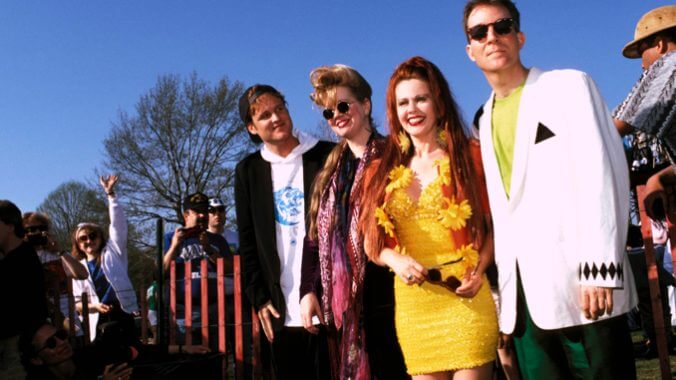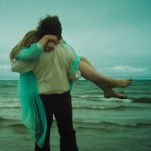Hero Worship: How The B-52’s Southern New Wave and Dial-Up Internet Saved My Life
B-52's photo by Ebet Roberts/Redferns/Getty
In 1991, my world changed. I’d been spending absent days in my suburban Pennsylvania middle school hiding in bathrooms with two friends who felt interim while the popular girls danced to Color Me Badd at in-school dances. Then we got Prodigy, an early internet service. This was a year or two before America Online started spamming the mailboxes (the real kind, with flags and hinges) of everyone I knew.
Prodigy’s stand-out feature was its message boards organized alphabetically by interest, and I went straight to the music section. I still wonder what would have happened had they chosen a name further down the alphabet. Instead, there it was, near the top of the list: salvation in blocky VGA font. “B-52s fans.”
I had Cosmic Thing; everyone had Cosmic Thing, that hit album featuring the ubiquitous “Love Shack.” But the cheeky, affectionate messages zipping around this group of self-proclaimed weirdos hinted at something more countercultural. For a day or two, I held back. Today, this would be called “lurking,” but that term connotes a self-awareness that I did not possess as a socially unconfident 13-year-old. When I opened a new board message and typed my question, I hesitated just briefly before hitting Enter. What album should I buy next? I asked. No question, responded someone: Wild Planet.
My first listen—boom box, bedroom floor—was completely disorienting. This sounded nothing like “Love Shack.” Instead of iridescent, polished production, here was jangly guitar. Instead of tidy kitsch, the wigs donned by Kate Pierson and Cindy Wilson on this album cover seemed deliberately strange, even ugly. The song “Running Around,” with its growling guitar and banshee yelling, felt almost scary to me. And irresistible.
I had zero grounding in camp or anything even vaguely queer. My upbringing had immersed me in classical music and Pink Floyd. My rust-belt hometown worshiped classic rock’s serious male swagger; I had just emerged the year before from a long Billy Joel phase. But this band, they weren’t even trying to be polished musicians; they were just having fun. As Fred Schneider put it before every live song on cassette tapes I was about to start trading, “This next song is a dance tune.” They were surrealist; they were hilarious; they were exactly the way I realized I wanted to be the moment I heard them. “I’ll give you fish/I’ll give you candy,” what?! The cotton candy hair, the 1960s thrift store dresses, the irresistible dance beat, Cindy Wilson’s Southern drawl—I was slain by it all.
In short order, I saved my allowance and bought the B-52’s’ first, self-titled album, listened, rejoiced, and waited some more while I saved up for the new-wave classic Whammy! I joined a fan club run by a woman in Rochester who mailed out monthly newsletters, some featuring song lyrics with hand-drawn illustrations. By the time Christmas rolled around and I received a VHS tape featuring a live performance of the B-52’s from 1979, I was all in, creeping downstairs in the night to stand as close as possible to the TV so that I didn’t wake my parents while I danced with abandon to “Rock Lobster.” I imagined I was wild, and maybe even…drunk? high? (whatever that was like) in a bygone version of Athens, GA, every cell in my body pining. I hung an early poster of the B-52’s over my dresser. I still recall one night marked by that fanatical, drifty insomnia in which all you can think of is the object of your obsession. I had fallen asleep with Party Out Of Bounds, a book about the ‘70s Athens music scene, next to me in bed, and now dreamed I was there, I was there!, repeatedly waking to look up at that poster, my body and spirit distilled to 100% longing.
-

-

-

-

-

-

-

-

-

-

-

-

-

-

-

-

-

-

-

-

-

-

-

-

-

-

-

-

-

-

-

-

-

-

-

-

-

-

-

-








































